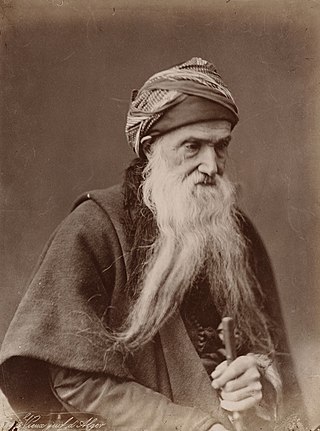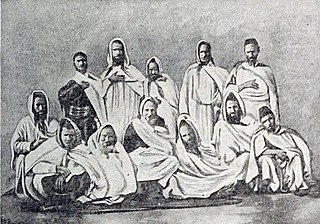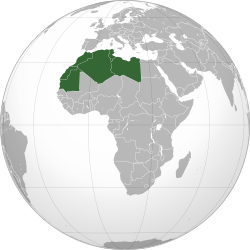
North Africa is a region encompassing the northern portion of the African continent. There is no singularly accepted scope for the region, and it is sometimes defined as stretching from the Atlantic shores of the Western Sahara in the west, to Egypt and Sudan's Red Sea coast in the east.

Berbers or the Berber peoples, also called by their endonym Amazigh or Imazighen, are a diverse grouping of distinct ethnic groups indigenous to North Africa who predate the arrival of Arabs in the Arab migrations to the Maghreb. Their main connections are identified by their usage of Berber languages, most of them mutually unintelligible, which are part of the Afroasiatic language family. They are indigenous to the Maghreb region of North Africa, where they live in scattered communities across parts of Morocco, Algeria, Libya, and to a lesser extent Tunisia, Mauritania, northern Mali and northern Niger. Smaller Berber communities are also found in Burkina Faso and Egypt's Siwa Oasis.
In the 20th century, approximately 900000 Jews migrated, fled, or were expelled from Muslim-majority countries throughout Africa and Asia. Primarily a consequence of the 1948 Arab–Israeli War, the mass movement mainly transpired from 1948 to the early 1970s, with one final exodus of Iranian Jews occurring shortly after the Islamic Revolution in 1979–1980. An estimated 650000 (72%) of these Jews resettled in Israel.

The Maghreb, also known as the Arab Maghreb and Northwest Africa, is the western part of the Arab world. The region comprises western and central North Africa, including Algeria, Libya, Mauritania, Morocco, and Tunisia. The Maghreb also includes the disputed territory of Western Sahara. As of 2018, the region had a population of over 100 million people.
North Africa has contributed considerably to popular music, especially Egyptian classical music alongside el Gil, Algerian raï and Chaabi. The broad region is sometimes called Maghreb, and the term Maghrebian music is in use. For a variety of reasons Libya does not have as extensive nor popular a tradition as its neighbours. Folk music abounds, however, despite frequent condemnation and suppression from governments, existing in multiple forms across the region—the Berbers, Sephardic Jews, Tuaregs, Copts and Nubians, for example, retain musical traditions with their ancient roots.

African Jewish communities include:

Mizrahi Jews, also known as Mizrahim (מִזְרָחִים) or Mizrachi (מִזְרָחִי) and alternatively referred to as Oriental Jews or Edot HaMizrach, are a grouping of Jewish communities that lived in the Muslim world.
Maghrebi Arabic is a vernacular Arabic dialect continuum spoken in the Maghreb. It includes the Moroccan, Algerian, Tunisian, Libyan, Hassaniya and Saharan Arabic dialects. It is known as ad-Dārija. This serves to differentiate the spoken vernacular from Literary Arabic. Maghrebi Arabic has a predominantly Semitic and Arabic vocabulary, although it contains a few Berber loanwords which represent 2–3% of the vocabulary of Libyan Arabic, 8–9% of Algerian and Tunisian Arabic, and 10–15% of Moroccan Arabic. Maghrebi Arabic was formerly spoken in Al-Andalus and Sicily until the 17th and 13th centuries, respectively, in the extinct forms of Andalusi Arabic and Siculo-Arabic. The Maltese language is believed to have its source in a language spoken in Muslim Sicily that ultimately originates from Tunisia, as it contains some typical Maghrebi Arabic areal characteristics.
Jewish ethnic divisions refer to many distinctive communities within the world's Jewish population. Although considered a self-identifying ethnicity, there are distinct ethnic subdivisions among Jews, most of which are primarily the result of geographic branching from an originating Israelite population, mixing with local communities, and subsequent independent evolutions.

The history of Jews in Algeria goes back to Antiquity, although it is not possible to trace with any certainty the time and circumstances of the arrival of the first Jews in what is now Algeria. In any case, several waves of immigration helped to increase the population. There may have been Jews in Carthage and present-day Algeria before the Roman conquest, but the development of Jewish communities is linked to the Roman presence. Jewish revolts in Israel and Cyrenaica in the 1st and 2nd centuries certainly led to the arrival of Jewish immigrants from these regions. The vast majority of scholarly sources reject the notion that there were any large-scale conversions of Berbers to Judaism.

The history of the Jews in Tunisia extends nearly two thousand years to the Punic era. The Jewish community in Tunisia is no doubt older and grew up following successive waves of immigration and proselytism before its development was hampered by anti-Jewish measures in the Byzantine Empire. The community formerly used its own dialect of Arabic. After the Muslim conquest of Tunisia, Tunisian Judaism went through periods of relative freedom or even cultural apogee to times of more marked discrimination. The arrival of Jews expelled from the Iberian peninsula, often through Livorno, greatly altered the country. Its economic, social and cultural situation has improved markedly with the advent of the French protectorate before being compromised during the Second World War, with the occupation of the country by the Axis. The Nakba and the creation of Israel in 1948 provoked a widespread anti-Zionist reaction in the Arab world, to which was added nationalist agitation, nationalization of enterprises, Arabization of education and part of the administration. Jews left Tunisia en masse from the 1950s onwards because of the problems raised and the hostile climate created by the Bizerte crisis in 1961 and the Six-Day War in 1967. According to the Jewish Virtual Library, the Jewish population of Tunisia, was estimated at about 105,000 individuals in 1948. These Jews lived mainly in Tunis, with communities present in Djerba. The 2022 Report on International Religious Freedom by The U.S Department of State stated that "according to members of the Jewish community, there are approximately 1,500 Jewish citizens in the country".

The culture of North Africa encompasses the customs and traditions of art, architecture, music, literature, lifestyle, philosophy, food, politics and religion that have been practiced and maintained by the numerous ethnic groups of North Africa. North Africa encompasses the northern portion of Africa, including a large portion of the Sahara Desert. The region's commonly defined boundaries include Algeria, Egypt, Libya, Morocco, Tunisia, and Western Sahara, stretching from the Atlantic shores of the Western Sahara in the west, to Egypt's Red Sea coast in the east. The United Nations' definition additionally includes Sudan in the region. The inhabitants of North Africa are roughly divided in a manner corresponding to the principal geographic regions of North Africa: the Maghreb, the Nile valley, and the Sahel.

Berber Jews are the Jewish communities of the Maghreb, in North Africa, who historically spoke Berber languages. Between 1950 and 1970 most emigrated to France, the United States, or Israel.

The Arab world consists of 22 states. As of 2021, the combined population of all the Arab states was around 475 million people.

Sfenj is a Maghrebi doughnut: a light, spongy ring of dough fried in oil. Sfenj is eaten plain, sprinkled with sugar, or soaked in honey. It is a well-known dish in the Maghreb and is traditionally made and sold early in the morning for breakfast or in the late afternoon accompanied by tea—usually Maghrebi mint tea—or coffee. The term Sfenj is used in Algeria and other parts of the Maghreb. It is called bambalouni in Tunisia, and Sfenj in Libya. In Morocco, the term "Sfenj" is used, also sometimes nicknamed in the literature "Moroccan doughnuts". It is also called Khfaf or ftayr in Algeria, and is sometimes also dubbed as the "Algerian doughnut".
Maghrebis or Maghrebians is a modern Arabic term meaning "Westerners", mainly referring to the inhabitants of the Maghreb region of North Africa, the western part of the Arab world. Maghrebis are predominantly of Arab and Berber or mixed Arab-Berber origins.

Moroccan Jews are Jews who live in or are from Morocco. Moroccan Jews constitute an ancient community dating to Roman times. Jews began immigrating to the region as early as 70 CE. They were later met by a second wave of migrants from the Iberian peninsula in the period which immediately preceded and followed the issuing of the 1492 Alhambra Decree, when Jews were expelled from Spain, and soon afterward, from Portugal. This second wave of immigrants changed Moroccan Jewry, which largely embraced the Andalusian Sephardic liturgy, to switch to a mostly Sephardic identity.
North African Americans are Americans with origins in the region of North Africa. This group includes Americans of Algerian, Egyptian, Libyan, Moroccan, and Tunisian descent.

The Paris metropolitan area has a large Maghrebi population, in part as a result of French colonial ties to that region. As of 2012 the majority of those of African origin living in Paris come from the Maghreb, including Algeria, Morocco, and Tunisia. There were 30,000 people with Algerian nationality, 21,000 persons with Moroccan nationality, and 15,000 persons with Tunisian nationality in the city of Paris in 2009. In addition, there are thousands of Maghrebi Jews who immigrated from Algeria, Tunisia and Morocco during the 1960s.
North African Sephardim are a distinct sub-group of Sephardi Jews, who descend from exiled Iberian Jewish families of the late 15th century and North African Maghrebi Jewish communities.
















